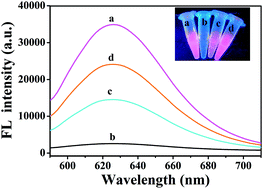A DNA–scaffolded silver nanocluster/Cu2+ ensemble as a turn-on fluorescent probe for histidine†
Abstract
A new type of rapid, sensitive, and selective fluorescence turn-on assay was developed for detection of histidine using a DNA–scaffolded silver nanocluster/Cu2+ ensemble (DNA–AgNC/Cu2+). Cu2+ was first bound to nucleic acids of the DNA–AgNCs forming a DNA–AgNC/Cu2+ ensemble and then liberated into solution via the highly specific interaction between histidine and Cu2+ in the presence of other amino acids. The fluorescence of DNA–AgNCs was greatly quenched with the addition of Cu2+, and then the DNA–AgNC/Cu2+ ensemble exhibited marvelous fluorescent enhancement in the presence of histidine, which showed the possibility for constructing a turn-on chemosensor of histidine. Compared to other methods, this approach promises high sensitivity, simplicity in design, convenient operation, and minimized use of organic solvents. The ultra-high selectivity demonstrated the feasibility of the assay for detecting histidine in sophisticated physical environments. The fitting range of the proposed assay is from 0 to 100 μM, with a detection limit of 1.4 μM (S/N = 3) in artificial urine samples. The protocol was evaluated by analysis of artificial urine samples with good recoveries and showed great potential for practical applications.


 Please wait while we load your content...
Please wait while we load your content...